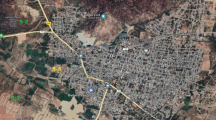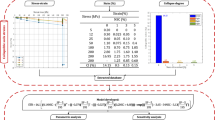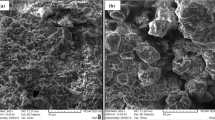Abstract
As a kind of problematic soil, collapsible soils can withstand relatively high stress in an unsaturated state. Still, upon wetting and being saturated, such soils show a significant sudden reduction in volume, causing damage to the structures. One of the environmentally friendly materials used to treat collapsible soils is the nano-clay as potential stabilizers. The present study investigates the nano-clay effect on the soil collapse treatment in the Sivand region, Fars Province, Iran. Further research proved to achieve fine dispersion of added nano-clay between the soil particles appropriately through the wet mixing method. To investigate effective soil collapse behavior parameters, 72 reconstructed samples with different water content, dry density, applied vertical stress, and nano-clay contents are tested using the static compaction method. The results indicate that soil collapse behavior is almost completely fixed using only 5% nano-clay. It has also been concluded that the collapse potential increases with reducing water content, dry density, nano-clay contents, while it has an increase if applied vertical stress increases. The extracted test results are used as a database to develop an efficient model to predict the soils’ collapse potential. Additionally, the parametric and sensitivity analyses confirm the model output with the test results.












































Similar content being viewed by others
Abbreviations
- PI:
-
Plastic index
- ωc:
-
Water content
- ωc,opt :
-
Optimum water content
- ωNc:
-
Nano-clay moisture
- Dp:
-
Nano-clay’s particle diameter
- ρNc:
-
Nano-clay’s density
- Gs:
-
Specific gravity
- ρmax:
-
Maximum dry density
- ρd:
-
Dry density
- e:
-
Void ratio
- V:
-
Specific volume
- SSA:
-
Specific surface area
- PH:
-
Potential of hydrogen
- κ:
-
Electric conductivity
- σv:
-
Applied vertical stress
- NCC:
-
Nano-clay content
- Ie:
-
Collapse index
- Ic:
-
Collapse potential
- SEM:
-
Scanning electron microscopy
- XRD:
-
X-ray diffraction analysis
- Fe2O3:
-
Ferric oxide
- TiO2:
-
Titanium dioxide
- CaO:
-
Calcium oxide
- K2O:
-
Potassium oxide
- SiO2:
-
Silicon dioxide
- Al2O3:
-
Aluminum oxide
- MgO:
-
Magnesium oxide
- Na2O:
-
Sodium oxide
- LiO:
-
Lithium oxide
References
Abbasi N, Farjad A, Sepehri S (2018) The use of nanoclay particles for stabilization of dispersive clayey soils. Geotech Geol Eng 36:327–335
Abd El Aal AK, Rouaiguia A (2020) Determination of the geotechnical parameters of soils behavior for safe future urban development Najran Area Saudi Arabia: implications for settlements mitigation. Geotech Geol Eng 38:695–712
Alani S, Hassan MS, Jaber AA, Ali IM (2020) Effects of elevated temperatures on strength and microstructure of mortar containing nano-calcined montmorillonite clay. Constr Build Mater 263:120895
Alawaji H (2001) Settlement and bearing capacity of geogrid-reinforced sand over collapsible soil. Geotext Geomembr 19:75–88
Alsafi S, Farzadnia N, Asadi A, Huat BK (2017) Collapsibility potential of gypseous soil stabilized with fly ash geopolymer characterization and assessment. Constr Build Mater 137:390–409
ASTMD854–14 (2014) Standard test methods for specific gravity of soil solids by water pycnometer. ASTM International, West Conshohocken
ASTMD1557–12e1 (2012) Standard test methods for laboratory compaction characteristics of soil using modified effort (56,000 ft-lbf/ft3 (2,700 kN-m/m3)). ASTM International, West Conshohocken
ASTMD2419–14 (2014) Standard test method for sand equivalent value of soils and fine aggregate. ASTM International, West Conshohocken
ASTMD2435/D2435M-11(2020) (2020) Standard test methods for one-dimensional consolidation properties of soils using incremental loading. ASTM International, West Conshohocken
ASTMD2487–11 (2011) Standard practice for classification of soils for engineering purposes (unified soil classification system). ASTM International, West Conshohocken
ASTMD4318 (2017) Standard test methods for liquid limit, plastic limit, and plasticity index of soils. ASTM International, West Conshohocken
ASTMD5333-03 2012 Standard test method for measurement of collapse potential of soils (Withdrawn 2012) ASTM International, West Conshohocken https://doi.org/10.1520/D5333-03
Barden L, McGown A, Collins K (1973) The collapse mechanism in partly saturated soil. Eng Geol 7:49–60
Basma AA, Tuncer ER (1992) Evaluation and control of collapsible soils. J Geotech Eng 118:1491–1504
Baziar MH, Saeidaskari J, Alibolandi M (2018) Effects of nanoclay on the treatment of core material in earth dams. J Mater Civ Eng 30:04018250
Bell F (1993) Engineering treatment of soils. CRC Press, Florida
Cao, G. (2004). Nanostructures & nanomaterials: synthesis, properties & applications, Imperial college press.
Clevenger WA (1959) Experiences with loess as a foundation material. T Am Soc Civ Eng 123:51–80
Coo JL, So ZP, Ng CW (2016) Effect of nanoparticles on the shrinkage properties of clay. Eng Geol 213:84–88
D698–12e2 A (2012) Standard test methods for laboratory compaction characteristics of soil using standard effort (12 400 ft-lbf/ft3 (600 kN-m/m3)). ASTM International, West Conshohocken
Das BM (2015) Principles of foundation engineering. Cengage learning, Boston
Das BM, Sobhan K (2013) Principles of geotechnical engineering. Cengage learning, Boston
Derbyshire E (2001) Geological hazards in loess terrain with particular reference to the loess regions of China. Earth-Sci Rev 54:231–260
Dudley, J. H. (1970). "Review of collapsing soils." J soil mech found div 96(3): 925-947.
El-Sohby M, Shook M, Elleboudy A (1987) Swelling and shear strength characteristics of Mokattan shale. In: Proc 9th Regional Conference for Africa on Soil Mechanics and Foundation Engineering, Lagos, Nigeria, pp 143–146
Evans G, Bell D (1981) Chemical stabilization of loess, New Zealand. In: Proceedings of the 10th International Conference on Soil Mechanics and Foundation Engineering. pp 649–658
Evstatiev D (1988) Loess improvement methods. Eng Geol 25:341–366
Feda, J. (1966). "Structural stability of subsident loess soil from Praha-Dejvice." Eng Geol 1(3): 201-219.
Ferreira C (2003) Function finding and the creation of numerical constants in gene expression programming. In: Advances in soft computing, Springer, pp 257–265
Ferreira C (2006) Gene expression programming: mathematical modeling by an artificial intelligence, vol 21. Springer
Garakani AA, Haeri SM, Khosravi A, Habibagahi G (2015) Hydro-mechanical behavior of undisturbed collapsible loessial soils under different stress state conditions. Eng Geol 195:28–41
German RM (1994) Powder metallurgy science Metal Powder Industries Federation. Princeton, New Jersey
Ghasabkolaei N, Choobbasti AJ, Roshan N, Ghasemi SE (2017) Geotechnical properties of the soils modified with nanomaterials: a comprehensive review. Arch Civ Mech Eng 17:639–650
Ghazi H, Baziar M, Mirkazemi S (2011) The effects of nano-material additives on the basic properties of soil. In: Proc of 14th Asian Regional Conference on Soil Mechanics and Geotechnical Engineering, Hong-Kong, pp 23–27
Gibbs HJ, Bara JP (1967) Stability problems of collapsing soil. J Soil Mech Found Div 93:577–594
Haeri SM, Khosravi A, Garakani AA, Ghazizadeh S (2017) Effect of soil structure and disturbance on hydromechanical behavior of collapsible loessial soils. Int J Geomech 17:04016021
Hanna A, Soliman S (2017) Experimental investigation of foundation on collapsible soils. J Geotech Geoenviron Eng 143:04017085
Holt W (1961) Settlement of soil foundation due to saturation. In: Proc of the 5th Int Conf on SMFE, pp 673–679
Hosseini A, Haeri SM, Mahvelati S, Fathi A (2019) Feasibility of using electrokinetics and nanomaterials to stabilize and improve collapsible soils. J Rock Mech Geotech Eng 11:1055–1065
Huang Y, Wen Z, Wang L, Zhu C (2019) Centrifuge testing of liquefaction mitigation effectiveness on sand foundations treated with nanoparticles. Eng Geol 249:249–256
Iranpour B (2016) The influence of nanomaterials on collapsible soil treatment. Eng Geol 205:40–53
Jefferson I, Rogers CD (2012) Collapsible Soils ICE Manual of Geotechnical Engineering 1:391–411
Jing Y, Jia Z, Zhang Z, Lv Y, Wang L, Tao C (2019) Study on the method for determination of the maximum depth of loess collapsible under overburden pressure. Bull Eng Geol Environ 1–13
Johari A, Golkarfard H (2018) Reliability analysis of unsaturated soil sites based on fundamental period throughout Shiraz Iran. Soil Dyn Earthq Eng 115:183–197
Johari, A., G. Habibagahi and A. Ghahramani (2006). "Prediction of soil–water characteristic curve using genetic programming." J Geotech Geoenviron Eng 132(5): 661-665.
Johari A, Habibagahi G, Nakhaee M (2013) Prediction of unsaturated soils effective stress parameter using gene expression programming. Sci Iran 20:1433–1444
Johari A, Nejad AH (2015) Prediction of soil-water characteristic curve using gene expression programming. Iran J Sci Technol Trans Civ Eng 39:143
Johari A, Talebi A, Heydari A (2020) Prediction of discharge flow rate beneath sheet piles using gene expression programming based on scaled boundary finite element modelling database. Sci Iran 28:645–655
Knight K (1961) The collapse of structure of sandy subsoils on wetting. University of the Witwatersrand, Johannesburg
Krishnan J, Shukla S (2019) The behaviour of soil stabilised with nanoparticles: an extensive review of the present status and its applications. Arab J Geosci 12:436
Lemieux M, Léonard G, Doucet J, Leclaire LA, Viens F, Chaouki J, Bertrand F (2008) Large-scale numerical investigation of solids mixing in a V-blender using the discrete element method. Powder Technol 181:205–216
Lin, Z. and S. Wang (1988). "Collapsibility and deformation characteristics of deep-seated loess in China." Eng Geol 25(2-4): 271-282.
Lutenegger AJ, Saber RT (1988) Determination of collapse potential of soils. Geotech Test J 11:173–178
Lutenegger, A. J. a. H., G. R. (1988). "Stability of Loess,” Eng Geol." 25(2): 247-261.
Lv Q, Chang C, Zhao B, Ma B (2018) Loess soil stabilization by means of SiO 2 nanoparticles. Soil Mech Found Eng 54:409–413
Miller H, Djerbib Y, Jefferson I, Smalley I (2002) Modelling the collapse of metastable loess soils. Nottingham Trent University, Nottingham
Mollahasani, A., A. H. Alavi and A. H. Gandomi (2011). "Empirical modeling of plate load test moduli of soil via gene expression programming." Comput Geotech 38(2): 281-286.
NRC (2006). Geological and geotechnical engineering in the new millennium: opportunities for research and technological innovation, National Academies Press.
Pengelly AD, Boehm DW, Rector E, Welsh JP (1997) Engineering experience with in-situ modification of collapsible and expansive soils. In: Unsaturated Soil Engineering Practice, ASCE, pp 277–298
Rogers C (1995) Types and distribution of collapsible soils. In: Genesis and properties of collapsible soils, Springer, pp 1–17
Rollins KM, Kim J (2010) Dynamic compaction of collapsible soils based on US case histories. J Geotech Geoenviron Eng 136:1178–1186
Rollins KM, Rogers GW (1994) Mitigation measures for small structures on collapsible alluvial soils. J Geotech Eng 120:1533–1553
Santos EC, Palmeira EM, Bathurst RJ (2013) Behaviour of a geogrid reinforced wall built with recycled construction and demolition waste backfill on a collapsible foundation. Geotext Geomembr 39:9–19
Sarli JM, Hadadi F, Bagheri RA (2020) Stabilizing geotechnical properties of loess soil by mixing recycled polyester fiber and nano-SiO 2. Geotech Geol Eng 38:1151–1163
Singhai SK, Chopra V, Nagar M, Jain N, Trivedi P (2010) Scale up factor determination of V blender: an overview. Der Pharmacia Lett 2:408–433
Smalley I, Ng’ambi S, (2019) Problems with collapsible soils: particle types and inter-particle bonding. Open Geosci 11:829–836
Swain AKP, Roy GK (2011) Mechanical operations. McGraw-Hill Education, New York
Tabarsa A, Latifi N, Meehan CL, Manahiloh KN (2018) Laboratory investigation and field evaluation of loess improvement using nanoclay–a sustainable material for construction. Const Build Mater 158:454–463
Tong Z (2007) Water-based suspension of polymer nanoclay composite prepared via miniemulsion polymerization. Georgia Institute of Technology, Atlanta
Valizade N, Tabarsa A (2020) Laboratory investigation of plant root reinforcement on the mechanical behaviour and collapse potential of loess soil. Eur J Environ Civ Eng 1–17
Wang J, Zhang D, Chen C, Wang S (2020) Measurement and modelling of stress-dependent water permeability of collapsible loess in China. Eng Geol 266:105393
Wilson MA, Tran NH, Milev AS, Kannangara GK, Volk H, Lu GM (2008) Nanomaterials in soils. Geoderma 146:291–302
Zhang G, Germaine J, Whittle A, Ladd C (2004) Index properties of a highly weathered old alluvium. Geotechnique 54:441–451
Zimbardo M, Ercoli L, Mistretta MC, Scaffaro R, Megna B (2020) Collapsible intact soil stabilisation using non-aqueous polymeric vehicle. Eng Geol 264:105334
Author information
Authors and Affiliations
Corresponding author
Rights and permissions
About this article
Cite this article
Johari, A., Golkarfard, H., Davoudi, F. et al. A predictive model based on the experimental investigation of collapsible soil treatment using nano-clay in the Sivand Dam region, Iran. Bull Eng Geol Environ 80, 6725–6748 (2021). https://doi.org/10.1007/s10064-021-02360-w
Received:
Accepted:
Published:
Issue Date:
DOI: https://doi.org/10.1007/s10064-021-02360-w




